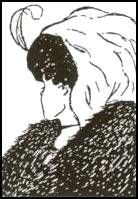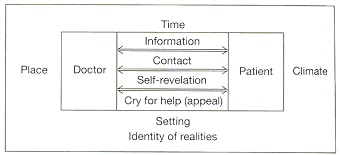| The theory decides what
we can observe. |
| Albert Einstein |
|
The identity of realities
is therefore the absolute and indispensable prerequisite of an understanding
doctor-patient discussion.
|
|
If it is not possible to find
an identical reality with the other, not only is discussion useless but
it can be downright dangerous, since misunderstandings are inevitable.
Not finding a mutual reality is probably one of the major reasons for disordered
communication between people, ranging from conflict between tenant and
landlord, through the generation differences right up to conflicts between
international power blocks.
The phenomenon of differing
realities and their relationship to transactions in communication has been
described in particular detail by Paul Watzlawick in his book "Wie wirklich
ist die Wirklichkeit?" (How real is reality?), which should be read by
anyone concerned with communication. The following 3 examples, which should
clearly explain the phenomenon of differing realities, have been taken
from Watzlawick's book.
1st Example:
A laboratory rat explained
the behaviour of the research worker to another rat: "I have trained this
human, so that he gives me food whenever I press on this lever". It is
obvious that the rat applies another law to that of the research worker
to the same sequence of reactions. The researcher sees the pressure of
the rat on the lever as a trained reaction to a stimulus that he
has just given it. However the reality of the rat is that pressing the
lever is a stimulus with which it lets the man know that
it wants food, to which he provides food as he has been trained to do by
the rat. Watzlawick: "In spite of the fact that both see the same thing
(event), they both attribute different meanings to it, and experience
two completely different realities from it".
2nd Example:
Tables of random numbers
are produced by a randomizer, which creates long lists of the 10 characters
in our system of counting. In one of the obviously random series of numbers,
0-1-2-3-4-5-6-7-8-9 suddenly appears. Our immediate impression would be
that the randomizer has "failed", as this series is completely organized
and could not be a coincidence or random. However the mathematician will
tell us otherwise; the series 0-1-2-3-4-5-6-7-8-9 is just as likely to
be ordered or random as any other combination of ciphers in our decimal
system. It is after all our arbitrariness which decides what counts
as a series and what not. The presumption that the series of numbers is
ordered is a typical reversal of the first (objective) and second (subjective)
order of reality. In objective reality, the series of numbers is
just as unordered as the series 4-1-5-9-2-6-3-7, but it appears to us to
be ordered in the subjective reality, as it follows principles that
we have laid down.
3rd Example:
A man arrived in heaven and
met an old friend, on whose knee sat a beautiful girl. "Wonderful", exclaimed
the newcomer, "is she your reward?" "Oh no", replied the old man sadly,
"I am her punishment".
Watzlawick calls the belief
that there is only one reality, "the most dangerous of all self-deceptions".
He insists "that there are more suppositions of reality than can be counted,
which can be very contradictory, all of which are the results of communication
and none of which reflect eternal objective reality".
There is said to be no absolute
reality, but only subjective, in part completely contradictory, presumptions
of reality. It is naive as well as dangerous to presume that one's own
subjective reality is the "true" reality. First order reality is that in
which aspects of reality are agreed upon by all concerned, and based on
experimental, repeatable and thereby verifiable evidence. Reality of the
first order can be defined unequivocally into physical and chemical categories
by scientific methods.
 Watzlawick
gives the example of gold: "The first order reality of gold (that is its
physical characteristics) are completely known and can be verified whenever
necessary. The meaning that gold has had in human life since ancient times
and the fact that it is given a value (which is a totally specific aspect
of reality) twice a day in the City of London, and that this attribution
of worth largely determines many other aspects of our reality - all this
has very little, if at all, to do with its physical characteristics. It
is however this second order reality of gold which can make one immensely
rich or bankrupt." Watzlawick
gives the example of gold: "The first order reality of gold (that is its
physical characteristics) are completely known and can be verified whenever
necessary. The meaning that gold has had in human life since ancient times
and the fact that it is given a value (which is a totally specific aspect
of reality) twice a day in the City of London, and that this attribution
of worth largely determines many other aspects of our reality - all this
has very little, if at all, to do with its physical characteristics. It
is however this second order reality of gold which can make one immensely
rich or bankrupt."
Discussion about the meaning
and the worth of events, facts or situations, although they may
be clearly defined in the first order of reality, is completely
different as they cannot be clearly defined. Meaning is highly subjective
and arbitrary. In fact a single thing may have very many realities of the
second order, and each of them is subjective and by itself "real". It is
absurd to fight over what is really "real" in second order reality. As
the subjective reality of the second order is as convincingly "real" as
is reality of the first order, there is a very great danger that we forget
the difference. It may be that we are not even aware of the existence of
two different sorts of reality.
At first glance at the picture
most people see the profile of a young lady, but others the face of an
old woman. The observer who does not manage to "switch" from seeing one
to suddenly seeing the other, can be given the following cues. The cheek
and jawline of the young lady makes up the long nose of the old woman.
The left eye of the old lady is the left ear of the young one.
The velvet neck-band of the
young lady is the mouth of the other and the right eye of the old woman
is a bit of the nose of the young one. Whichever woman was seen first is
the "right" one. However this was not the only "right" face that could
be seen in the picture. In other words, our perceptions of truth are always
"correct", but they may not be the only single, correct and possible perception.
It is the differing individual perceptions of one and the same thing which
create the various subjective realities, of which that of one person is
just as real as that of another.
It cannot be overemphasized
just how vital it is to recognize the phenomenon of first and second order
realities, and what fatal misunderstandings can arise from ignorance of
differing realities or not taking them into account.
If the doctor is unsuccessful
in grasping the individual reality of a patient with whom he is speaking,
and in finding a common reality, all his efforts will be in vain and perhaps
even dangerous. Asking oneself: "Am I and my patient talking about
an identical reality?" is of fundamental importance. It is amazing
that
even brilliant scientists have difficulties in accepting that there is
not only one reality. For example, in 1926 Heisenberg attempted
to convince Einstein that only things which could be observed should
be used for the construction of a theory. It appears that Einstein had
changed his views in the meanwhile and is said to have answered: "It is
thoroughly incorrect to try to construct a theory only out of that which
can be observed. In reality, the opposite applies. The theory decides what
we can observe." In other words, it is not what we see that decides our
perception, but our perception decides what we see.
Von Uexküll also emphasized
the fundamental importance of the phenomenon of differing realities. He
insists that human life is characterized by a fundamental paradox:
"We live in two apparently mutually exclusive forms of existence. On one
hand we are unable to extricate ourselves from enclosure in our individual
reality. Each of us can only be sensitive to his own sensitivities, feel
his own feelings, think his own thoughts. However hard we try, we can never
ever be sensitive to what others are sensitive to, feel their feelings
as they feel them or think their thoughts, even when they are those we
know best. We can not overcome the boundaries which separate our world
from that of others. Every one remains an outsider with regard to the reality
of the other." He goes on: "On the other hand it is irrefutable that we
are just as much bound up with other people in common realities. These
common realities also have limits (barriers) which separate the insider
from the outsider. We recognize the common reality of theoretical physicists,
barristers or doctors, just to name a few examples ... Our social world
is a highly complicated tissue, in which the boundaries of the most varied
sorts of realities overlap. Recognition of this fact touches on the basic
question of how communication (that is, a connection between two individual
realities) is actually possible." Von Uexküll gives the answer: "Only
if a common reality can be achieved".

The linkages in discussions
between doctor and patient.
This poses the problem of how
a common reality can be found. To solve this, it is very important
to recognize so-called semantic barriers where the realities differ. Semantic
barriers separate insiders (who understand the code) from outsiders (who
have not achieved this code). The signs by which the insiders interpret
their reality and understand one another, must remain incomprehensible
to the outsider. This fact can be better understood if the term "rules
of play" are used instead of the word "code". If one knows the rules of
chess, one can either play or watch the common reality of "playing chess"
- one is an insider; those who do not know the rules remain outsiders,
for whom chess presents a completely incomprehensible reality. "The problem
of communication can be described as the search for common rules of play
or common codes", says von Uexküll.
| The determination of a common
reality is the foundation of communication between doctor and patient and
of course also the foundation of communication between all people. |
|
Only on finding a common reality
are people able to understand each other and to deal with each other correctly.
Discussion is the ideal method by which people seek a common code, find
it and at the same time make sure that they have found this code.
Von Uexküll: "Doctors
and patients live in different realities. Doctors and nurses see pain,
of which patients complain, as a symptom of disease which has an objective
course. This is above the head of the patient as an outsider. He is enclosed
within his own reality, in which pain and illness have a fateful meaning."
The task of the doctor is to determine a common code for these different
realities, or common rules of play: that is, to find an identical reality
with the patient. Understanding and successful communication is impossible
without it.
| top |
 |
| previous page |
 |
| next page |
 |
|
|
Linus
Geisler: Doctor and patient - a partnership through dialogue
|
|
©
Pharma Verlag Frankfurt/Germany, 1991
|
|
URL
of this page: http://www.linus-geisler.de/dp/dp05_reality.html
|
|